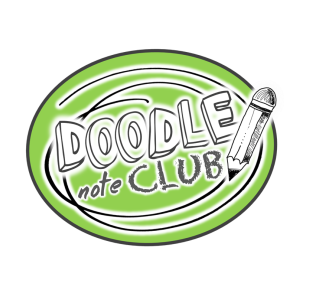TASKS FOR DOODLE NOTE ENGAGEMENT
It’s important to have students engage in a variety of tasks, and mix in as many as possible that will integrate both hemispheres of the brain.
This increases the brain’s ability to process the information and convert it to long-term memory to recall later. To boost student retention, try incorporating some of these types of tasks into your own doodle note lessons.
It can be a challenge to develop a good set of student tasks for each different lesson, but use these to inspire you and get brainstorming!
COLOR CODING

This doodle note page on subject and predicate has students color-code in the practice area as they identify the parts of the sentences. (Shared in the Share Zone)

When practicing the new concept of scarcity, students color code to identify which items are scarce. (shared by Wendy in the Share Zone)
FILL IN THE BLANKS

Filling in the critical information helps students to identify and focus in on the key ideas. Ideally, they print these words in a fun lettering style. Teach your students to really engage their right brains as they write in the vocabulary words or key ideas. This will help them recall the important terms and concepts later!
(This page on Hurricanes and Tornadoes is shared by Dawn in the Share Zone.)

Get creative with your fill-in tasks! Some can be blanks, some key terms can go inside of shapes, and some can be in empty spaces. (Converting measurements doodle note set is available here.)
SKETCHING

Leave some blank spaces or boxes for your students to add their own sketches. This will help them with their own understanding of the big ideas. If they can sketch it, then they probably get it, but more importantly, they will remember really well what they drew for themselves.
Encourage them to try their best – it’s ok if the drawings are not fancy or perfect.

Here, students sketch out the main concept of intersecting, parallel, or identical lines to help them grasp the big picture of what is going on for each situation of solutions of a system. (Shared by Glennan in the Share Zone)
LABELING

By using creative lettering, colors, and doodles within the label shapes, students can identify each part of an expression. (Shared by Jennifer in the Share Zone)

Students can do fun, colorful, artistic lettering to label or classify items. This engages the right hemisphere of the brain and also builds the potential for retaining the information. (States of Matter page is in the Share Zone.)
EXAMPLE QUESTIONS
Including sample questions, tasks, or problems is always a great idea during notes. It offers practice and helps students actually start to apply a new idea to the situations in which they’ll be seeing it.

Try creatively blending other task ideas into your practice examples to boost student engagement, focus, and memory of the material. This example (German page on Nominative vs. Accusative Case shared by Jen Gray in the Share Zone) allows students to label subjects and objects in sentences, then write key terms in the circles.

This creative example (shared by Katherine in the Share Zone) allows students to interact and then do a quick practice writing sample.

This practice task requires students to use color and pattern to show that they understand nets and the difference between pyramids and prisms. You can also sometimes allow students to set up their own pattern and color classifications and make a key to allow for more creativity. (Nets page shared by Jennifer in the Share Zone)
“TO-DO” / “TO-DOODLE” LIST

Have students interact with a diagram, drawing, or graphic by giving them a “to-do” list. This can require them to label, color/shade, answer questions, sketch a doodle, or anything that works for your lesson!

In this page on Combining Like Terms, students have to interact with the terms in the blender. The to-do list includes adding helpful invisible parts, then classifying with colors and patterns, and embellishing key ideas on the page.
REFLECTION / FREE DOODLE
To sum up or bring information together, you may want to include opportunities for free doodles, additional sketch notes, or other student input. Try leaving a little extra space for students to add their own creative take on the lesson. They can each build their own visual memory triggers!

This sample (sermon notes – shared in the Share Zone by Dawn) allows students to sketch, do lettering, or combine both into graphics that will boost their brains through Dual Coding Theory!
Hopefully, these samples will get your wheels turning as you try to develop your own student input areas on your next doodle lesson page! Thanks so much to everyone who has shared such inspiring and creative work!
